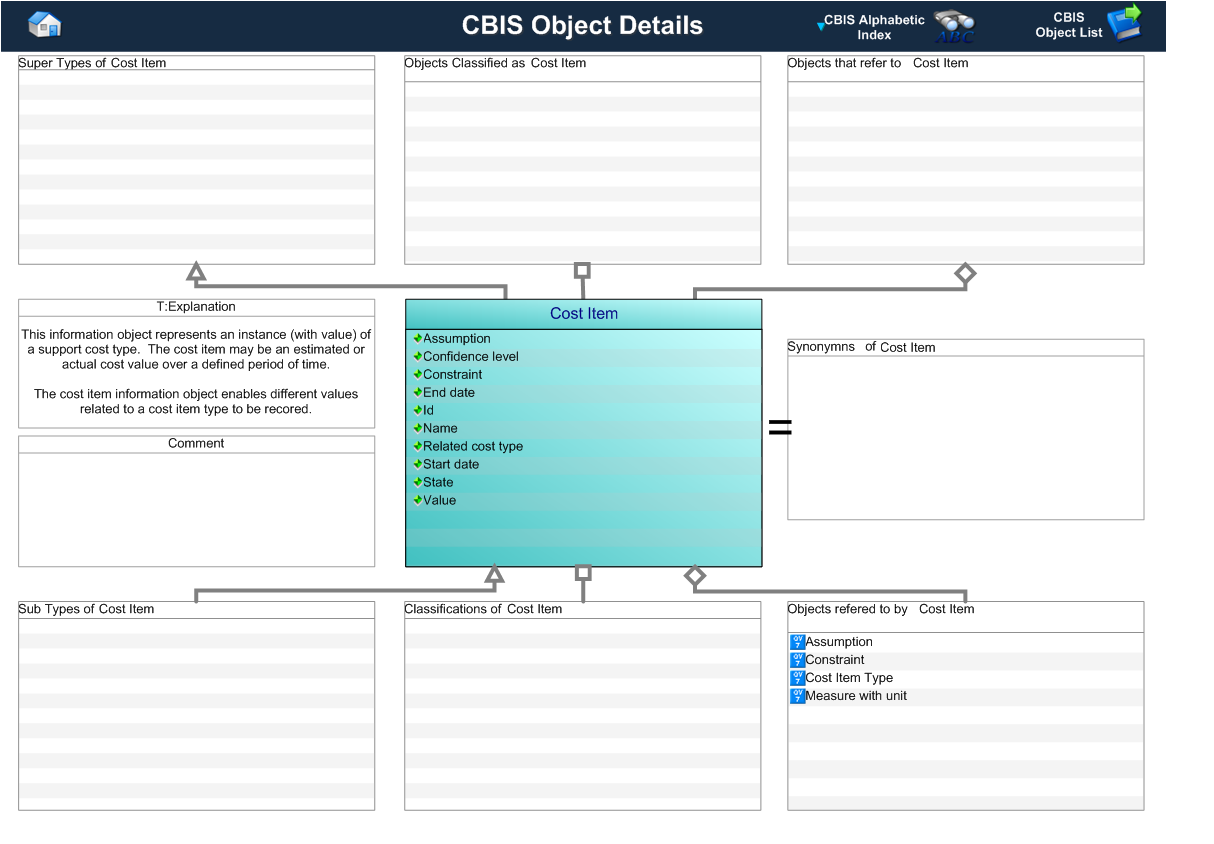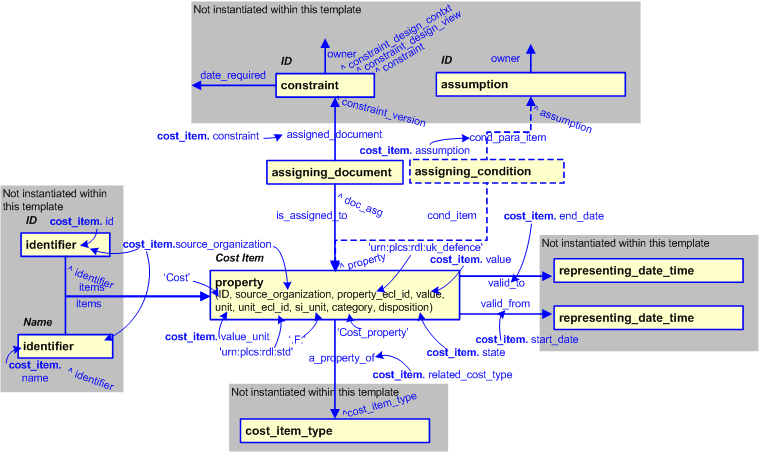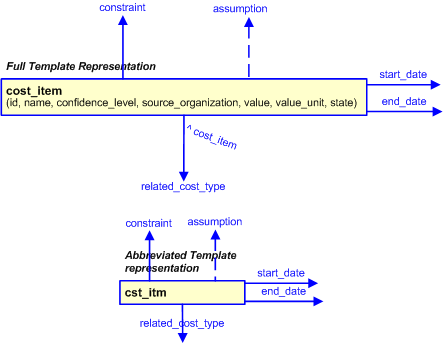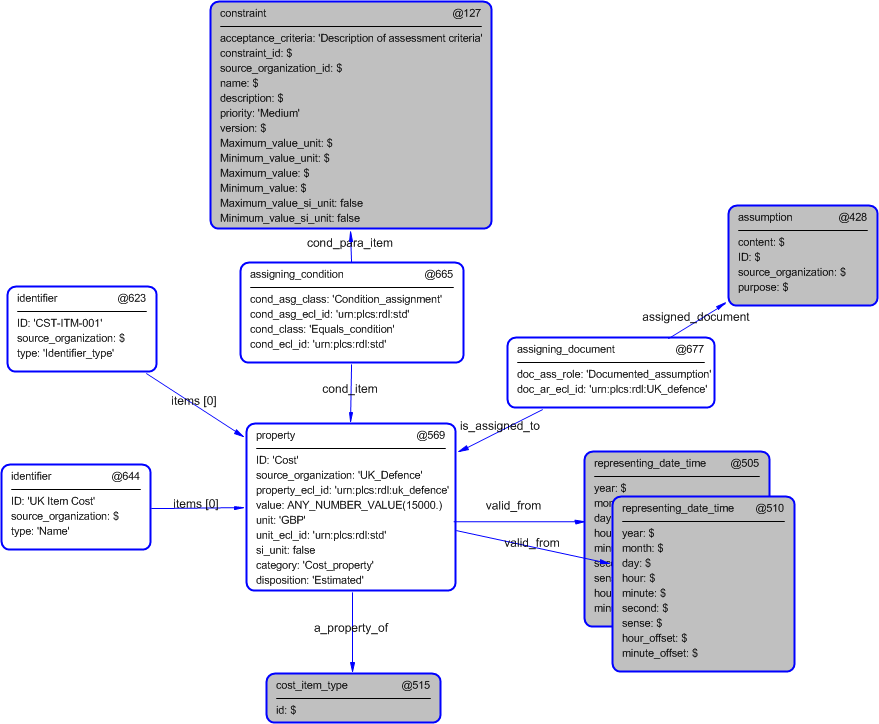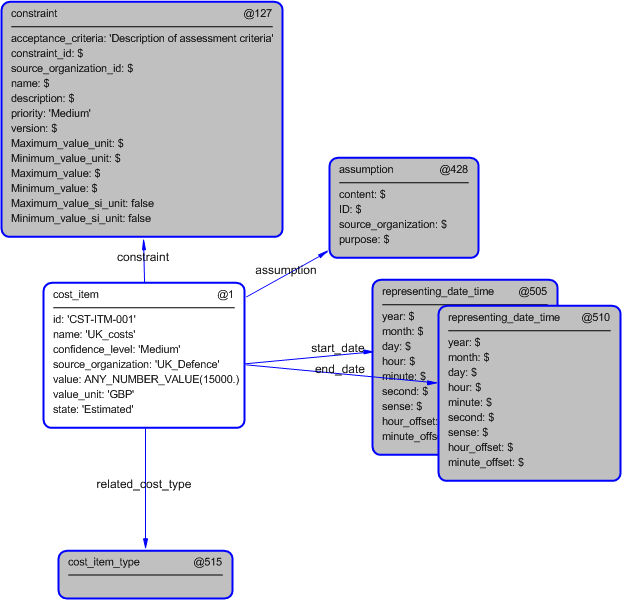Template:— cost_item (cst_itm)
Context:— UK_Defence |
Date: 2010/03/15 14:22:42
Revision: 1.3
|
This section specifies the template cost_item.
NOTE
The template has been defined in the context of
UK_Defence.
Refer to the business context for details of related templates.
NOTE
An explanation of a template and the associated instantiation path is
provided in the
Template overview
section.
This template describes how to represent an instance (with value) of a support cost type. The cost item may be an estimated
or actual cost value over a defined period of time.
The Cost Item business object is used by those UK_Defence Data Exchange Specifications that require information about
support cost items.
The cost item information object enables different values related to a cost item type to be recorded.
Figure 1 — Graphical Representation for Business Object Cost Item
Cost Item
The definition of the Cost Item object is:
This information to represent the record of an instance (with value) of a support cost type
|
Attribute name
|
Attribute description
|
Attribute type
|
Optionality
|
| Assumption |
This is a reference to a related assumption. |
Relationship to Assumption |
Optional |
| Confidence level |
This is the level of confidence attached the value of the cost item. |
Intrinsic |
Mandatory |
| Constraint |
This is a reference to a related Constraint. |
Relationship to Constraint. |
Mandatory |
| End date |
This is the end date of the period over which the cost item has been defined. |
Relationship to Date |
Mandatory |
| Id |
This is the identifier of the cost item. |
Intrinsic |
Mandatory |
| Name |
This is the name of the cost item. |
Intrinsic |
Mandatory |
| Related cost type |
This is the reference to the document that contains the results of the analysis. |
Relationship to Cost Item Type |
Mandatory |
| Start date |
This is the start date of the period over which the cost item has been defined. |
Relationship to Date |
Mandatory |
| State |
This is the state of the cost item. This attribute is used to distinguish between estimated and actual costs. State values
may include: Planned, Estimate or Actual.
|
Intrinsic |
Mandatory |
| Value |
This is the value of the cost item. |
Relationship to Measure (value) and unit |
Mandatory |
Table 1 — Cost Item attribute details.
The EXPRESS-G diagram in
Figure
2
shows the templates and EXPRESS entities that are required
to represent the template
"cost_item".
The text highlighted in blue shows the template parameters.
Figure 2 — An EXPRESS-G representation of the Information model for cost_item
The graphic for the template to be used in other EXPRESS-G diagrams
is shown in Figure
3
below.
Figure 3 — The graphical representation of the cost_item template
The following input parameters are defined for this template:
The cost item type to which the cost item is assigned.
The cost item type to which the cost item is assigned.
The identifier of the cost item.
The name of the cost item.
The name of the cost item.
The organization that created the associated identifier. Additionally
a Person or Information System could be defined when either of these are the source; see Identifier template characterizations
The value of the cost item.
The data type must also be indicated in this parameter, e.g.
"ANY_NUMBER_VALUE(5)".
The class name of the unit in which the value is expressed.
The following classes and their sub-classes can be used:
state (Default=Estimated,Type='CLASS')
The state (of disposition) of the cost item.
The following classes and their sub-classes can be used:
classifications: [Disposition]![[warning:]](../../../../../../images/dex/warning.gif) Error RDL4: The URI urn:plcs:rdl:uk_defence is not listed in dexlib/data/refdata/rdl_index.xml
Error RDL4: The URI urn:plcs:rdl:uk_defence is not listed in dexlib/data/refdata/rdl_index.xml
The cost item type to which the cost item is assigned.
This is the date and time from which the cost item was valid.
This is the date and time from which the cost item was valid.
The following reference parameters are defined for this template:
Allow the
Assigned_property
entity instantiated in this path to be referenced when this template is used.
%^target = $cost_item.cost_item%
The instantiation path shown below specifies the entities that are to be
instantiated by the template.
A description of templates and the syntax for the instantiation path is
provided in the
Templates Help/Information section.
-- Create the Property to record the cost value /
property(
ID='Cost',
source_organization=@source_organization,
property_ecl_id='urn:plcs:rdl:std',
value=@value,
unit=@value_unit,
unit_ecl_id='urn:plcs:rdl:std',
si_unit='.F.',
category='Cost_property',
disposition=@state,
a_property_of=@related_cost_type,
valid_from=@start_date,
valid_to=@end_date)/
-- Assign reference parameter to the assigned_property %^cost_item = $property.property%
-- [Optional Relationship to Assumption] /
assigning_document(
assigned_document=@assumption,
doc_ass_role='Documented_assumption',
doc_ar_ecl_id='urn:plcs:rdl:UK_Defence',
is_assigned_to=^cost_item)/
-- Relationship to Constraint (as a cosntraint) -- ideally would use requirement assignment but requires schema change to point to an assigned_poperty. /
assigning_condition(
cond_item=^cost_item,
cond_asg_class='Condition_assignment',
cond_asg_ecl_id='urn:plcs:rdl:std',
cond_class='Equals_condition',
cond_ecl_id='urn:plcs:rdl:std',
cond_para_item=@constraint)/
-- Confidence Level /
assigning_descriptor(
descr=@confidence_level,
class_name='Description',
ecl_id='urn:plcs:rdl:uk_defence',
is_assigned_to=^cost_item)/
/
identifier(
ID=@id,
source_organization=@source_organization,
type='Identification_code',
items=^cost_item)/
/
identifier(
ID=@name,
source_organization=@source_organization,
type='Name',
items=^cost_item)/
The instance diagram in Figure
4
shows an example of the EXPRESS entities and templates that are instantiated by the template:
/cost_item(assumption='@428', constraint='@127', id='CST-ITM-001', name='UK Item Cost', confidence_level='Medium', source_organization='UK_Defence', value='ANY_NUMBER_VALUE(15000.)', value_unit='GBP', state='ESTIMATED', related_cost_type='@515', start_date='@505', end_date='@510')/
(an illustration of the consolidated cost_item template is shown in
Figure
5 below.)
Figure 4 — Entities instantiated by cost_item template
The instance diagram in
Figure
5
shows the graphic symbol for the template that is to be
used in other instance diagrams. The example template is:
/cost_item(assumption='@428', constraint='@127', id='CST-ITM-001', name='UK Item Cost', confidence_level='Medium', source_organization='UK_Defence', value='ANY_NUMBER_VALUE(15000.)', value_unit='GBP', state='ESTIMATED', related_cost_type='@515', start_date='@505', end_date='@510')/
Figure 5 — Instantiation of cost_item template
Characterizations
No common characterizations of the template
cost_item
have been identified. However, the ISO 10303-239 EXPRESS model
may enable other assignments to the entities instantiated by the template.
